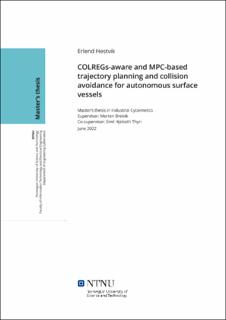| dc.contributor.advisor | Breivik, Morten | |
| dc.contributor.advisor | Thyri, Emil Hjelseth | |
| dc.contributor.author | Hestvik, Erlend | |
| dc.date.accessioned | 2022-09-24T17:20:35Z | |
| dc.date.available | 2022-09-24T17:20:35Z | |
| dc.date.issued | 2022 | |
| dc.identifier | no.ntnu:inspera:102231297:46961811 | |
| dc.identifier.uri | https://hdl.handle.net/11250/3021095 | |
| dc.description.abstract | Et fullt autonomt sjøfartøy må ha både baneplanlegging og kollisjonsungåelse systemer. Egenskapen til å følge et referansespor med tids- og andre
effektivitetbegrensninger er helt essensielt for å ha et brukbart autonomt sjøfartøy. Det er heller ikke nok å bare følge en referanse, fartøyet må
klare å unngå kollisjoner med andre fartøy som kan være både selvstyrt eller autonome i tillegg til statiske hindringer. Selv om det er et mål
å unngå kollisjoner er det endelige målet med kollisjonsungåelse å klare å forholde seg til COLREGs reglene for sjøvett, regler som alle
sjøfartøy må forholde seg til. I denne masteroppgaven skal det utvilkes en COLREGs forstående baneplanlegger algoritme som klarer å unngå
både statiske hindringer og andre fartøy. Algoritmen er basert på en kontrollmetode kalt MPC og bruken av numerisk optimalisering til baneplanlegging
vil bli undersøkt som en del av oppgaven.
Algoritmen will bli testet i forskjellige simulerte scenarier konstuert til å teste forskjellige deler av baneplanlegging og kollisjonsungåelse båe
i individe- og hybridtester. Et annen punkt som vil bli undersøkt er bruken av en hypotetisk prediksjonsalgoritme som skal klare å forstå hensikten bak
andre fartøys manøvere. Hvert scenarie kommer til å bli testet to ganger, den første gangen har den utviklede algoritmen tilgang til perfekt informasjon
om andre fartøy, mens den andre gangen må algoritmen selv prøve å forutse banen til andre båter med linære metoder. Denne måten å teste på er ment for
å undersøke potensielle fordeler med å utvikle mer avnaserte prediksjonsalgoritmer. | |
| dc.description.abstract | A fully autonomous surface vessel will need both trajectory planning and collision avoidance systems. The ability to track a reference path
with temporal or other efficiency constraints is essential for the usefulness of the \gls{ASV}. It is also not enough to simply follow a path
optimally, the vessel must be able to evade collisions with other vessels both manned and unmanned as well as avoid static obstacles. While avoiding collisions
is one goal, the real goal of collision avoidance is to achieve full \gls{COLREGs} compliance, a set of rules which every vessel on the sea must adhere to.
In this thesis, a COLREGs aware trajectory planning algorithm capable of avoiding both static obstacles and other vessels is developed.
The algorithm will be based on \gls{MPC} and the viability of numerical optimal control for mid-level trajectory planning will be examined.
The algorithm will be tested in a variety of simulated scenarios designed to stress different aspects of trajectory planning and collision
avoidance both individually and in combined situations. An additional point of examination will be the usage of hypothetical intention inferring methods
and prediction of other vessels. Each scenario simulation will be conducted twice; in one version the developed algorithm is allowed near
perfect information about the other vessels, while in the other it must linearly interpolate their course. This test will analyze the potential
usefulness of improving prediction methods. | |
| dc.language | eng | |
| dc.publisher | NTNU | |
| dc.title | COLREGs-aware and MPC-based trajectory planning and collision avoidance for autonomous surface vessels | |
| dc.type | Master thesis | |
